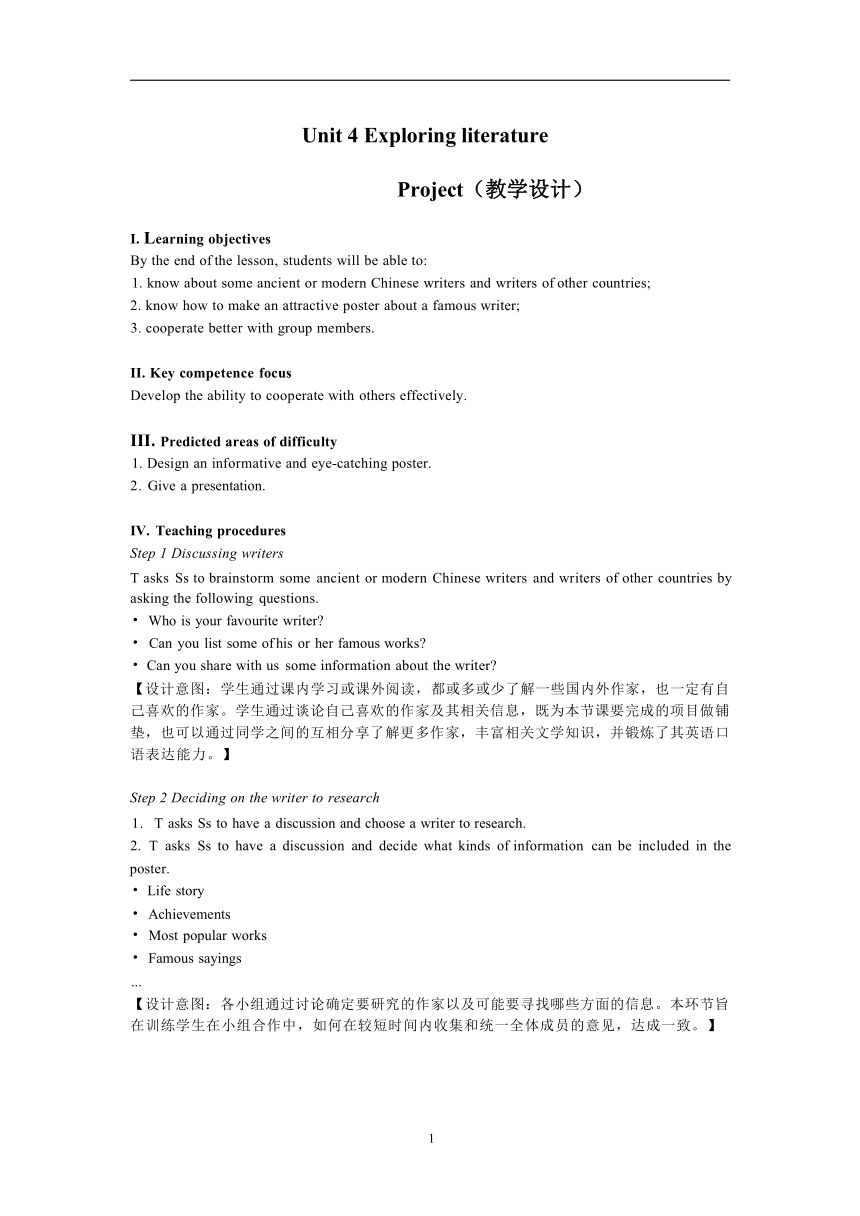
Unit 4 Exploring literature Project(教学设计) I. Learning objectives By the end of the lesson, students will be able to: 1. know about some ancient or modern Chinese writers and writers of other countries; 2. know how to make an attractive poster about a famous writer; 3. cooperate better with group members. II. Key competence focus Develop the ability to cooperate with others effectively. III. Predicted areas of difficulty 1. Design an informative and eye-catching poster. 2. Give a presentation. IV. Teaching procedures Step 1 Discussing writers T asks Ss to brainstorm some ancient or modern Chinese writers and writers of other countries by asking the following questions. Who is your favourite writer Can you list some of his or her famous works Can you share with us some information about the writer 【设计意图:学生通过课内学习或课外阅读,都或多或少了解一些国内外作家,也一定有自 己喜欢的作家。学生通过谈论自己喜欢的作家及其相关信息,既为本节课要完成的项目做铺 垫,也可以通过同学之间的互相分享了解更多作家,丰富相关文学知识,并锻炼了其英语口 语表达能力。】 Step 2 Deciding on the writer to research 1. T asks Ss to have a discussion and choose a writer to research. 2. T asks Ss to have a discussion and decide what kinds of information can be included in the poster. Life story Achievements Most popular works Famous sayings ... 【设计意图:各小组通过讨论确定要研究的作家以及可能要寻找哪些方面的信息。本环节旨 在训练学生在小组合作中,如何在较短时间内收集和统一全体成员的意见,达成一致。】 1 Step 3 Learning about poster design 1. T introduces the poster and the poster design. What is a poster A poster is a large notice, often with a picture on it, that is put in a public place to advertise something. What is poster design Poster design is the way to convey the message to the audience in a unique way. Design your poster carefully so that it is readable and eye-catching, by using proper art elements such as colours, typefaces, images, etc. 2. T introduces the elements of a poster. Pictures: They should be relevant, attractive and clear. Content: It should provide important information in a concise manner. Style: It means to display the content with the proper layout, colour, character size, etc. 3. T introduces the various layers of a poster by using the sample poster in part C on page 55 of the textbook. Headline: This is the main and largest text element in the design. You should choose a typeface that is interesting and attractive (or a proper style of calligraphy if your poster is done by hand). It should be large enough for people to read from a distance. Subheading: This part tells readers about the main parts of the poster so that they can quickly find the information they are interested in. As for sizing, there are two options—you can drop the size to about half of the main headline for very clear hierarchy or continue to use a larger size and use another technique to show contrast. Details: This part provides detailed information in a concise manner ... ...
~~ 您好,已阅读到文档的结尾了 ~~

